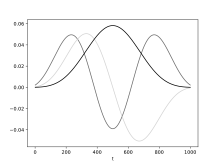David Slepian
David Slepian | |
|---|---|
Bell Telephone Laboratories | |
| Thesis | (1949) |
David S. Slepian (June 30, 1923 – November 29, 2007) was an American
algebraic coding theory, probability theory, and distributed source coding. He was colleagues with Claude Shannon and Richard Hamming at Bell Labs
.
Life and work
Born in
B.Sc. at University of Michigan before joining the US Army in World War II
,
as a Ghost army
.
He received his Ph.D. from Harvard University
in 1949, writing his dissertation in physics. After post-doctoral work at the
algebraic coding theory on group codes, first published in the paper A Class of Binary Signaling Alphabets. Here, he also worked along with other information theory giants such as Claude Shannon and Richard Hamming. He also proved the possibility of singular detection, a perhaps unintuitive result. He is also known for Slepian's lemma in probability theory
(1962), and for discovering a fundamental result in
Jack Keil Wolf
(1973).
He later joined the University of Hawaiʻi. His father was Joseph Slepian, also a scientist.[1] His wife is the noted children's author Jan Slepian.
Slepians

Slepian's joint work with H.J. Landau and H.O. Pollak on discrete prolate spheroidal wave functions and sequences (DPSWF, DPSS) eventually led to the naming of the sequences as "Slepians".[2][3][4][5][6] The naming suggestion was provided by Bob Parker of Scripp's Institute of Oceanography, who suggested that "discrete prolate spheroidal sequences" was a "mouthful".
This work was fundamental to the development of the multitaper, where the discrete form are used as an integral component.
Awards
- IEEE Fellow
- Fellow of Institute of Mathematical Statistics
- IEEE Information Theory Group 1974, and due to this also the Shannon Lecturer 1974.[7]
- National Academy of Engineering elected member 1976[8]
- National Academy of Sciences elected member 1977[9]
- IEEE Alexander Graham Bell Medal 1981[10]
- IEEE Centennial Medal 1984
- Society for Industrial and Applied Mathematics’s John von Neumann lecture award 1982
- American Academy of Arts and Sciences elected member
References
- IEEE. Retrieved February 22, 2011.
- BSTJ. Retrieved June 15, 2012.
- BSTJ. Retrieved June 15, 2012.
- BSTJ. Retrieved June 15, 2012.
- BSTJ. Retrieved June 15, 2012.
- BSTJ. Retrieved June 15, 2012.
- IEEE Information Theory Society. Archived from the originalon June 30, 2012. Retrieved February 22, 2011.
- United States National Academy of Engineering. Retrieved February 22, 2011.
- United States National Academy of Sciences. Retrieved February 22, 2011.
- IEEE. Retrieved February 22, 2011.
